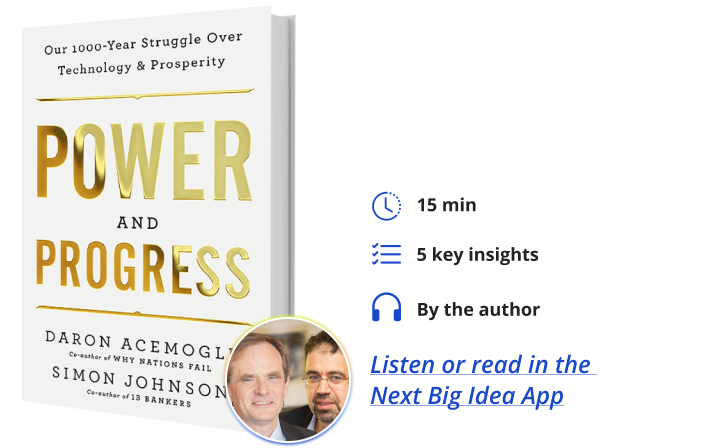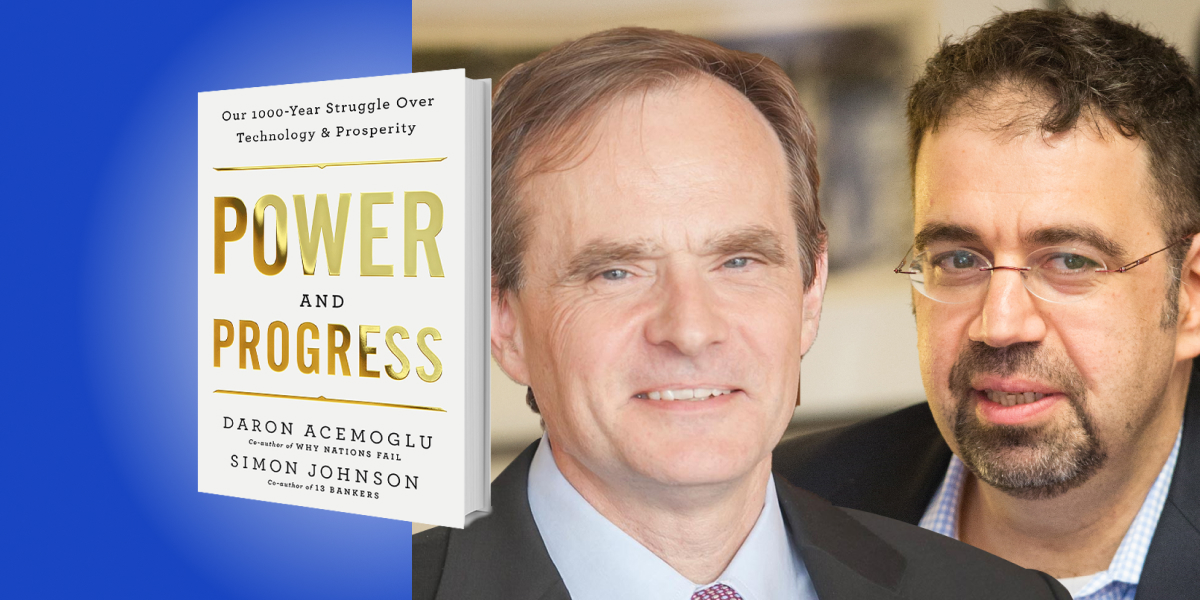Daron Acemoglu is a New York Times bestselling author, award-winning economist, and Institute Professor of Economics at MIT, the university’s highest faculty honor. Acemoglu was awarded the Bates Clark Medal, given to economists under forty for significant contributions to economic thought and knowledge.
Simon Johnson is a best-selling author and the Ronald A. Kurtz Professor of Entrepreneurship at the Sloan School at MIT, where he is also head of the Global Economics and Management group. Previously he was chief economist at the International Monetary Fund. His work has been published in The New York Times, The Washington Post, The Wall Street Journal, The Atlantic, and Financial Times.
Below, Simon and Daron share 5 key insights from their new book, Power and Progress: Our Thousand-Year Struggle Over Technology and Prosperity. Listen to the audio version—read by Simon—in the Next Big Idea App.

1. Improving technology does not always lead to prosperity.
This might seem like a strange idea. We’ve become very used to people claiming that in order to increase wages, improve living standards and expand opportunities, we need technological change and innovation. But unfortunately, when you look at the historical record, it’s much more complicated than that.
There are many instances before the modern era when technological changes and improvements did not lead to shared prosperity. One example is the spread of watermills and the adoption of windmills during medieval times. These advancements led to higher productivity in agriculture, but not to higher prosperity, because most of the labor was neither voluntary nor well-compensated: peons were forced to work the land of those in power.
Those people who had power, of course, did very well because of the higher productivity. They collected enough money to build fantastic medieval cathedrals in Western Europe. That wealth was not shared with the peasants: their wages did not go up, their living standards were abysmal, and disease was everywhere. The whole episode ended with the Black Death.
Another example is the cotton gin in the American South. Another is the first 100 years of industrialization in England—including in the north of England. The story is consistently the same in these cases: increases in productivity, even dramatic increases, do not necessarily produce shared prosperity. Perhaps they produce fortunes for a few people, but not always broad-based, shared prosperity.
2. Technology is necessary for prosperity, but it is shaped by choices.
Improving technology is essential to economic development. This sounds like it could conflict with the first insight, but the key to reconciling the two is to focus on what creates shared prosperity: choices and competing visions.
What does it take to share the gains from higher productivity? It’s a political process; who has political power? It’s also a social process; who has prestige? Who can shape the vision of what you should do with technology? What are we going to build? Are we going to educate people? Who is going to participate in “high-productivity” work? Are these workers going to be paid more money to go along with that productivity?
“A few individuals, one way or the other, can tip the balance.”
Interestingly, this is a new idea for economics. Economists are generally more comfortable with the idea that big processes, not individuals, drove economic history. But if you look back at the choices that we’ve made, the visions that shaped those societies, and the kinds of technology that were developed, you realize that it’s very much about leadership. There’s a huge role for charisma. A few individuals, one way or the other, can tip the balance.
We want technology to improve, but you only get shared prosperity when you work at it, through political and social processes.
3. Shared prosperity requires new tasks, countervailing powers, political representation, and regulation.
What is required for prosperity to be shared? One requirement is that, when machines arrive to “automate away” some tasks, new tasks must be created.
A good example is Henry Ford and the innovations that he brought to assembly line production—particularly when he electrified production, which he did on a bigger and more-effective scale than anyone had done before. That led to automation: some parts of car assembly that had been done by hand were now done by machines.
Simultaneously, Henry Ford and the broader economy—both upstream (providing the components that went into cars) and downstream (how cars were used)—generated new tasks and created new jobs. The scale of the transformation was enormous: from about 30,000 cars manufactured in the U.S. in 1900, to two to three million cars manufactured in the 1920s. This increased the demand for labor. When you increase the demand for labor, wages, or “price” of labor, tend to rise.
Related is the development of countervailing power. Henry Ford was a very powerful individual. At the same time—partly because the demand for labor was so strong—trade unions developed. Those trade unions wanted rules, protections for workers, and higher wages. This created a countervailing power against the power of Henry Ford and the “industrial barons.” That counterbalance was important to the overall growth and shared prosperity.
“When machines arrive to ‘automate away’ some tasks, new tasks must be created.”
An associated force is broader political representation. Across the industrializing world in the late-19th century and early-20th century was an “expansion of the franchise.” Workers gained a stronger political voice, which helped them get more rights, better treatment, higher wages, and improved living standards.
At the same time, governments of those countries (the U.S., UK, and other parts of Western Europe) developed the ability to better regulate business. There was a rise in antitrust thinking so monopolies were no longer tolerated. There were constraints on how you could treat customers; for example, the railways were not allowed to engage in price gouging. Also, corporate profits were (for the first time) meaningfully taxed, which took a share of the gains that industrialists were receiving from expanded productivity to fund public education and health systems—key elements of shared prosperity.
4. We had it right, but since the 1980s, we’ve gotten it wrong.
In the early- and mid-20th century, we did counterbalance industrialists’ power, without choking-off productivity gains. Innovation occurred, technology changed, and wages for everyone pretty much rose in that period.
But after 1980, there was a big switch in the ideology of how to run a business. The new ideology is often described as “shareholder primacy,” the idea that shareholders come first. While that idea has been around for a long time, after 1980 the emphasis changed. An influential set of people persuaded policymakers and businesspeople that shareholder primacy meant that you had to squeeze workers as hard as you could.
That was not the prevailing philosophy of U.S. business in the 1920s, which was a more-conciliatory, cooperative approach. But after 1980, there was a big squeeze on workers, which can be seen in relative wages. The wages of people with a lot of education continued to rise after 1980, but the wages of people with less education (e.g., people who didn’t finish high school) declined in relative terms (i.e., lower wages for less-educated versus more-educated workers). For some, the decline was in absolute terms (i.e., lower wages for less-educated workers in 2000 versus 1980).
“After 1980, there was a big squeeze on workers, which can be seen in relative wages.”
The forces which bolstered shared prosperity (new-task creation for less-educated workers, countervailing powers, political representation, and regulatory abilities of government) all became weaker in the digital age. While productivity has continued to grow, it has not grown very much, and this growth has not been shared, as it was in the U.S. and elsewhere during the 1940s–1960s.
So, if you think about social achievement on a broad base, you could say that we have snatched defeat from the jaws of victory. We had overcome the major problems of industrialization (e.g., disease, coercion, representation). We had brought most people together with rising wages and improving living standards. After 1980, things fell apart.
5. We should focus on machine usefulness over machine intelligence.
We’re in the middle of another wave of innovation: generative AI. ChatGPT, launched in November 2022, comes from an alliance led by Microsoft. There are other versions like Google’s rival, Bard product. Perhaps there will only be two or a few powerful companies in this space. It doesn’t seem likely that there will be many.
There are key choices that are still to-be made around generative AI. The prevailing philosophy among leaders of the tech industry is focused on machine intelligence, i.e., making machines able to do things that humans can do, perhaps to replace us in those tasks.
That, we think, is not a good idea. We would prefer an alternative tradition in computer science that emphasizes machine usefulness, i.e., developing technology that helps people become more productive, including workers with less education. If we can find ways to raise the productivity of workers and if (a big IF) that higher productivity can be converted into higher wages—through worker power, regulation, and societal pressure—then that is the key to shared prosperity.
If the machines displace people, if automation rules, if we don’t create enough new tasks, then that technology will have less-positive effects on shared prosperity. Some people may still make fortunes, technology could still impact the overall average productivity level and perhaps there might be a higher output or higher GDP (a key measure that economists track).
But are you going to have participation in that prosperity for everyone? Or, instead, do you need to have at least a college degree (or even an advanced degree, like a Ph.D.) to participate and to gain as generative AI rolls out? These are the questions, and this is the right moment, to have this discussion. We encourage everyone to consider the best ways to build a more pro-human, pro-humanist path for technological development.
To listen to the audio version read by co-author Simon Johnson, download the Next Big Idea App today:
































